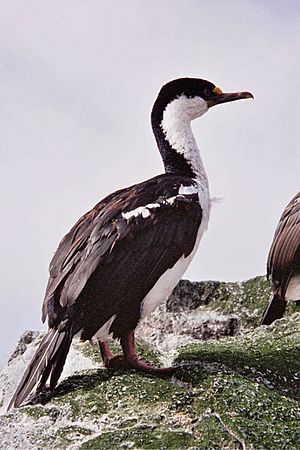Macquarie shag facts for kids
Quick facts for kids Macquarie shag |
|
|---|---|
 |
|
| Scientific classification | |
| Genus: |
Leucocarbo
|
| Species: |
purpurascens
|
| Synonyms | |
|
|
The Macquarie shag (Leucocarbo purpurascens) is a special type of cormorant. It is also known as the Macquarie Island shag or Macquarie Island cormorant. This marine bird lives only around Macquarie Island. This island is in the Southern Ocean. It is located about halfway between Australia and Antarctica.
Contents
What is a Macquarie Shag?
The Macquarie shag is part of a group called the blue-eyed shags. Scientists sometimes place it in different groups like Leucocarbo or Notocarbo. Other scientists might put it in the group Phalacrocorax. Today, most experts agree it is its own unique species.
Where Do Macquarie Shags Live?
Macquarie shags live only on subantarctic Macquarie Island. They also live on the nearby Bishop and Clerk Islets. These islets are about 33 kilometers (20 miles) south of Macquarie Island. When they are not breeding or resting, these birds spend their time in the ocean.
What Does a Macquarie Shag Look Like?
The Macquarie shag has mostly black feathers on its upper body. Its belly and chest are white. Its upper cheeks and the feathers covering its ears are black. It has white stripes on its wings. A black, curved crest sits on its forehead. Its feet are pink.
When a Macquarie shag is ready to breed, it looks even more colorful. It grows two orange bumps, called caruncles, above its beak and in front of its eyes. The skin on its face near the lower part of its beak turns orange-brown. It also has bright blue rings around its eyes. This bird is about 75 centimeters (30 inches) long. Its wingspan can reach 110 centimeters (43 inches). It weighs between 2.5 and 3.5 kilograms (5.5 to 7.7 pounds).
Macquarie Shag Behavior
Macquarie shags like to be with other birds. They often rest together in groups. These groups can be small, with just a few birds. They can also be very large, with hundreds of shags.
Macquarie Shag Reproduction
These birds stay on Macquarie Island all year long. They breed every year in colonies. These colonies can be small or large. They build their nests on bare rocky shores and sea stacks. Nest building starts in June. Their nests are shaped like cones. They are about 20–30 centimeters (8–12 inches) tall. The birds build them from plants, guano (bird droppings), and mud.
Female shags lay two or three eggs. This happens between mid-September and January. Most eggs are laid in late September and early November. Most chicks hatch by late December. By mid-February, most young birds can take care of themselves.
How Macquarie Shags Find Food
Macquarie shags look for food close to the coast. They hunt in shallow ocean waters. Their main food is fish that live on the seafloor. Sometimes, many shags will hunt for food together in a group.
Macquarie Shag Conservation Status
In the year 2000, scientists estimated there were about 760 breeding pairs of Macquarie shags. This included 100 pairs on the Bishop and Clerk Islets. A survey in October 2003 found fewer birds. There were 472 nesting pairs on Macquarie Island itself. This showed a 30% drop in their numbers.
The Macquarie shag is listed as a Vulnerable animal. This means it is at risk of becoming endangered. It is listed under Australia's Environment Protection and Biodiversity Conservation Act 1999. The population is small and lives in a specific area. Their breeding success can change a lot. This is due to weather and how much food is available. Other dangers include predators like Subantarctic skuas and black rats. These animals sometimes eat young birds in their nests.
See also
 In Spanish: Cormorán de la Macquarie para niños
In Spanish: Cormorán de la Macquarie para niños

